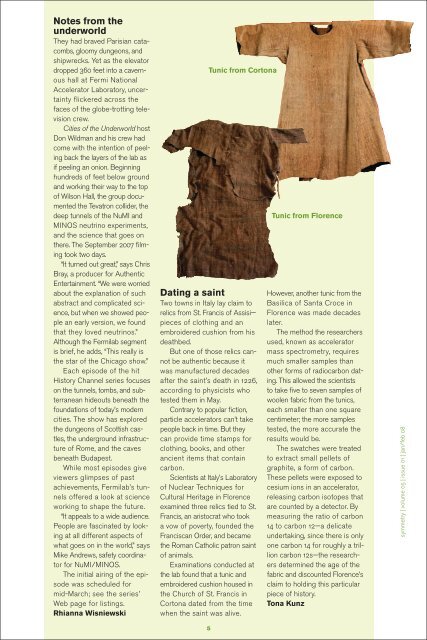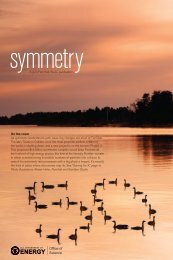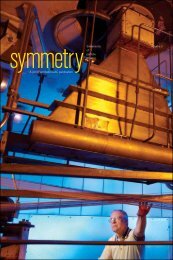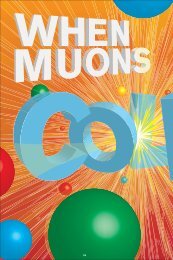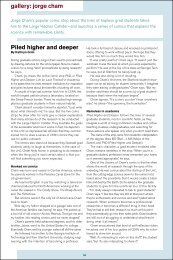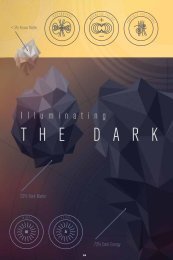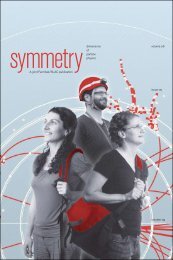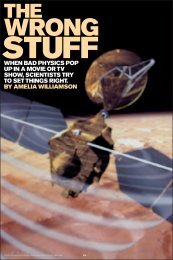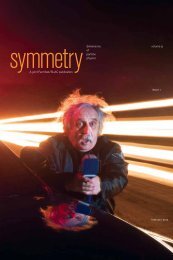Download Issue PDF - Symmetry magazine
Download Issue PDF - Symmetry magazine
Download Issue PDF - Symmetry magazine
You also want an ePaper? Increase the reach of your titles
YUMPU automatically turns print PDFs into web optimized ePapers that Google loves.
Notes from theunderworldThey had braved Parisian catacombs,gloomy dungeons, andshipwrecks. Yet as the elevatordropped 360 feet into a cavernoushall at Fermi NationalAccelerator Laboratory, uncertaintyflickered across thefaces of the globe-trotting televisioncrew.Cities of the Underworld hostDon Wildman and his crew hadcome with the intention of peelingback the layers of the lab asif peeling an onion. Beginninghundreds of feet below groundand working their way to the topof Wilson Hall, the group documentedthe Tevatron collider, thedeep tunnels of the NuMI andMINOS neutrino experiments,and the science that goes onthere. The September 2007 filmingtook two days.“It turned out great,” says ChrisBray, a producer for AuthenticEntertainment. “We were worriedabout the explanation of suchabstract and complicated science,but when we showed peoplean early version, we foundthat they loved neutrinos.”Although the Fermilab segmentis brief, he adds, “This really isthe star of the Chicago show.”Each episode of the hitHistory Channel series focuseson the tunnels, tombs, and subterraneanhideouts beneath thefoundations of today’s moderncities. The show has exploredthe dungeons of Scottish castles,the underground infrastructureof Rome, and the cavesbeneath Budapest.While most episodes giveviewers glimpses of pastachievements, Fermilab’s tunnelsoffered a look at scienceworking to shape the future.“It appeals to a wide audience.People are fascinated by lookingat all different aspects ofwhat goes on in the world,” saysMike Andrews, safety coordinatorfor NuMI/MINOS.The initial airing of the episodewas scheduled formid-March; see the series’Web page for listings.Rhianna WisniewskiTunic from CortonaDating a saintTwo towns in Italy lay claim torelics from St. Francis of Assisi—pieces of clothing and anembroidered cushion from hisdeathbed.But one of those relics cannotbe authentic because itwas manufactured decadesafter the saint’s death in 1226,according to physicists whotested them in May.Contrary to popular fiction,particle accelerators can’t takepeople back in time. But theycan provide time stamps forclothing, books, and otherancient items that containcarbon.Scientists at Italy’s Laboratoryof Nuclear Techniques forCultural Heritage in Florenceexamined three relics tied to St.Francis, an aristocrat who tooka vow of poverty, founded theFranciscan Order, and becamethe Roman Catholic patron saintof animals.Examinations conducted atthe lab found that a tunic andembroidered cushion housed inthe Church of St. Francis inCortona dated from the timewhen the saint was alive.5Tunic from FlorenceHowever, another tunic from theBasilica of Santa Croce inFlorence was made decadeslater.The method the researchersused, known as acceleratormass spectrometry, requiresmuch smaller samples thanother forms of radiocarbon dating.This allowed the scientiststo take five to seven samples ofwoolen fabric from the tunics,each smaller than one squarecentimeter; the more samplestested, the more accurate theresults would be.The swatches were treatedto extract small pellets ofgraphite, a form of carbon.These pellets were exposed tocesium ions in an accelerator,releasing carbon isotopes thatare counted by a detector. Bymeasuring the ratio of carbon14 to carbon 12—a delicateundertaking, since there is onlyone carbon 14 for roughly a trillioncarbon 12s—the researchersdetermined the age of thefabric and discounted Florence’sclaim to holding this particularpiece of history.Tona Kunzsymmetry | volume 05 | issue 01 | jan/feb 08


